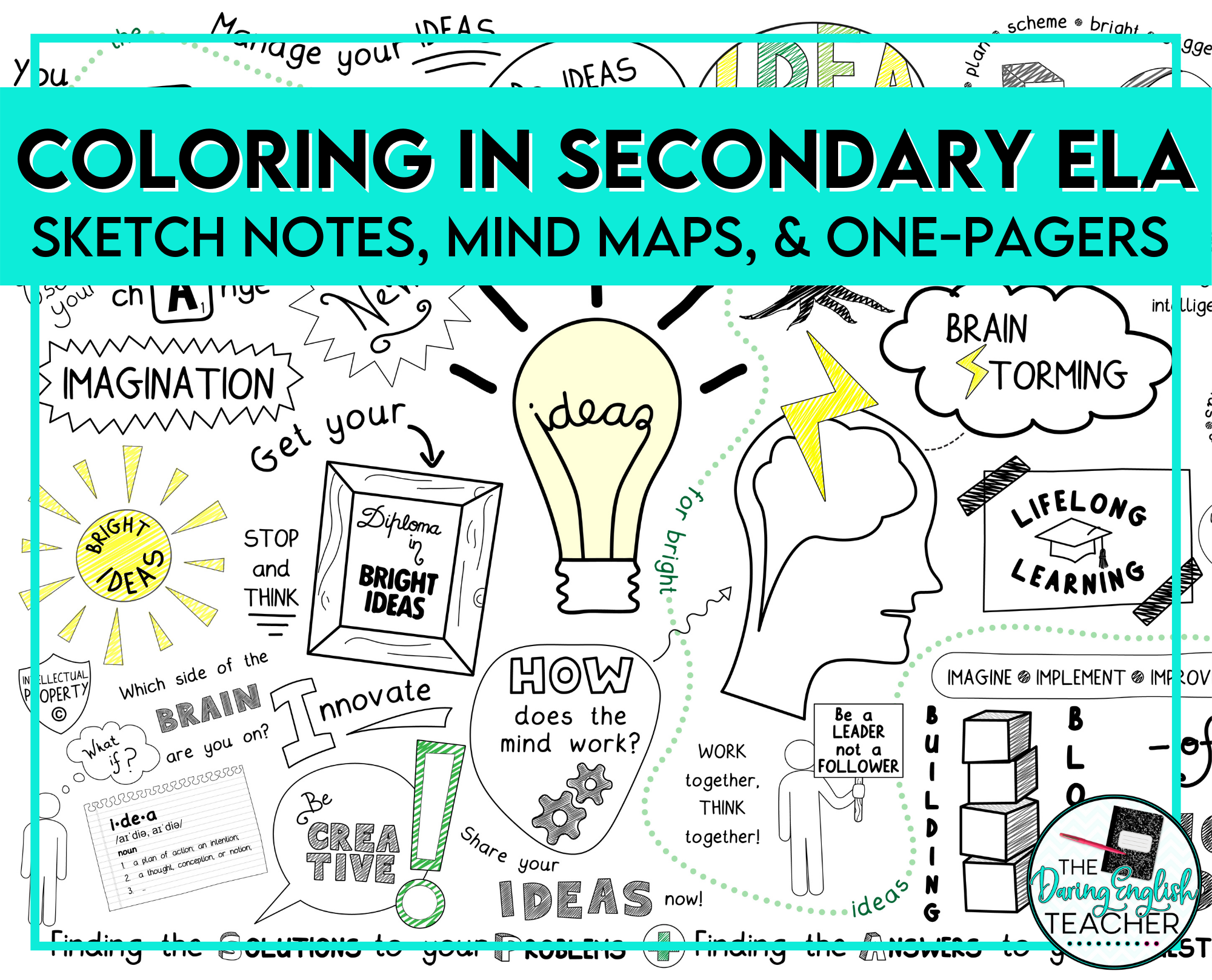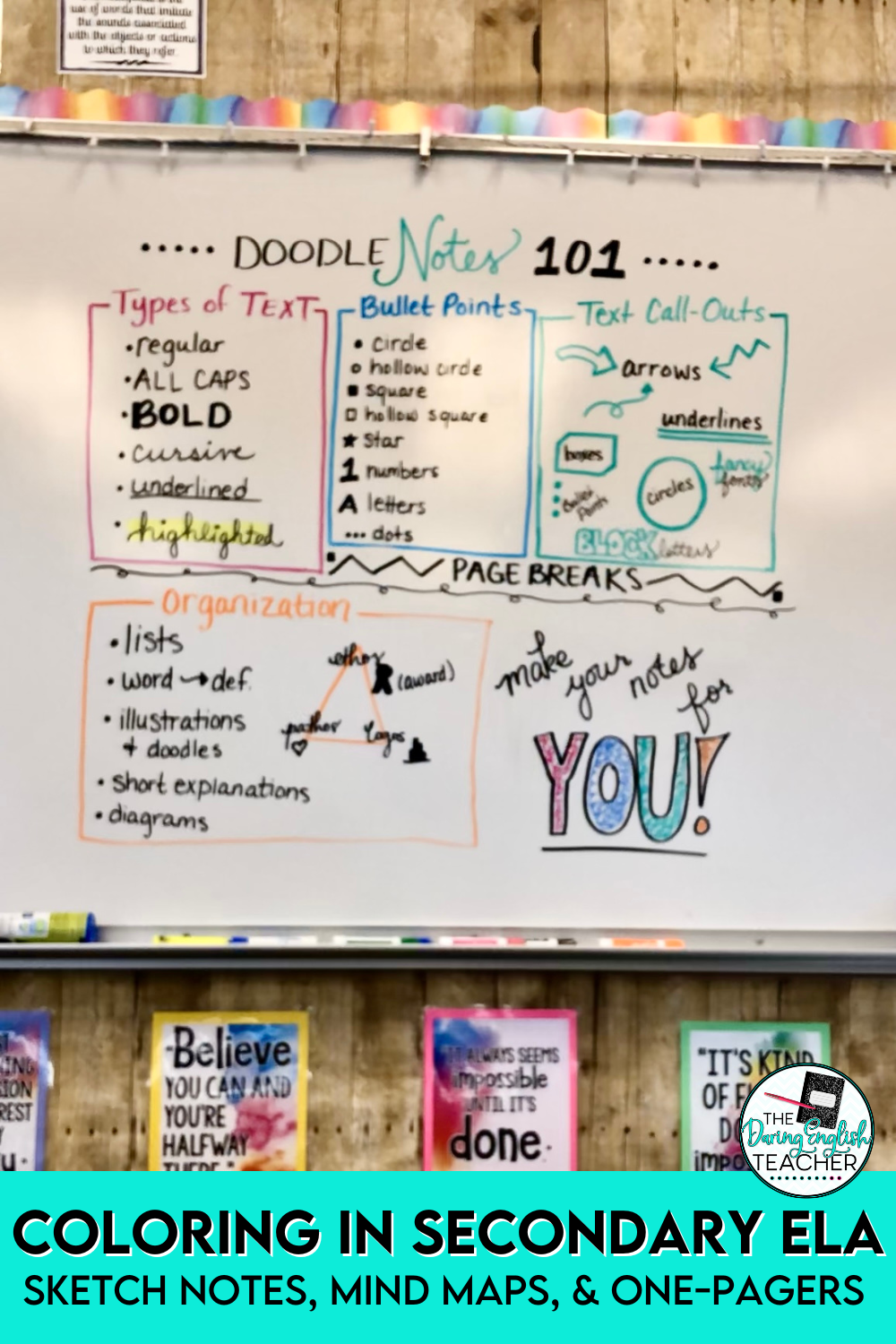When it comes to engaging middle school ELA and high school English students, I’ve noticed a pretty consistent trend: teens like to color, doodle, and create. As much as some teens might moan and groan about coloring, it’s actually quite therapeutic, and it helps many disengaged students focus on the lesson, assignment, or assessment.
However, when it comes to coloring in the classroom, all coloring-type assignments are not created equally and should not be used synonymously. In fact, sketch notes and doodle notes, mind maps, and one-pagers all have their own distinct place and purpose in the classroom. And when used effectively, these activities and assignments help unlock students’ creativity and analysis skills.
Before diving into the different coloring activities, it is important to have the materials you need to successfully facilitate these assignments in the classroom. There have been quite a few times when I walked into my classroom at the start of a school day not planning on coloring, but I throw it in because at the last moment I felt that it would serve a purpose in my daily lesson. This blog post contains affiliate links that help cover the cost of the blog.
Supplies for Sketch notes, mind maps, and one-pagers
While some students might have the coloring supplies they need, not every student does. I usually have a supply box at each table with markers so each student can still create. Every two to three years, I stock up at the big box stores when markers are only $1. In addition to having coloring supplies, I also like to keep several different sizes of paper handy. My favorite sizes are 11×17 inch tabloid paper and 8.5×14 inch legal paper. Sometimes I provide the students with a choice of which size to use, and other times I dedicate a size to the assignment.
Here is a list of some of my favorite supplies for coloring in the classroom:
Deciding on a Coloring Activity for Secondary ELA
Now that you’ve got your supplies all set up, it is time to decide between one of the three main types of coloring activities for the secondary ELA classroom: sketch notes, mind maps, or one-pagers. Here is a run-down of each.
Sketch notes and doodle notes
Sketch notes are visual notes that combine sketches and doodles along with words, visual elements, and graphical elements. Before beginning the sketch notes and doodle notes, I usually show students examples of images from Google, and I also draw some visual elements on the board for them to see.
Sketch notes are ideal for:
- Recording information as you learn it
- Class notes for direct instruction
Mind Maps
Like sketch notes, mind maps are another visual medium that combines illustrations and words to record and present information. However, unlike sketch notes, mind maps model what a synapse of a brain looks like. Mind maps have a centralized idea written and illustrated, and then have branches coming off of that centralized idea, each with related information. Just like I do with sketch notes, I turn to Google to share visual examples with my students (HINT: I find the best and most-detailed examples I can to inspire my students), and I also show them pictures of brain synapses so they can see the visual connection.
To help out struggling students, it is a good idea to help them with the centralized idea and then provide them with a list of topics for the branches. During my Long Way Down unit, I have my students create a mind map as we read Will’s journey. You can read more about that assignment in this mind map.
Mind maps are ideal for:
- Reviewing a book
- Presenting information on a concept
- Mapping one’s thinking about a topic
- Organizing and classifying information
- Showing comparisons and connections between stories in a genre
One-pagers
Finally, we come to one-pagers. Unlike sketch notes and mind maps which are primarily used for learning information, gathering information, and presenting information, a one-pager is more of a formal assessment where students combine visual and written information to demonstrate their understanding and analysis of a topic. I assign one-pagers at the end of a unit rather than before and during the unit.
At the end of my Night unit, I assign a one-pager to my students where they demonstrate not only their understanding of the story and its themes, but also provide additional connections and analysis. You can read more about that assignment in this blog post.
One-pagers are ideal for:
- Final assessment
- Demonstrating understanding of concepts
- An alternate assignment instead of an analysis essay
- Showing visual and written analysis



